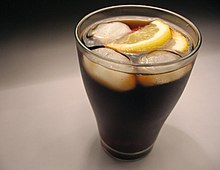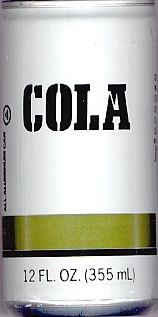Cola: Difference between revisions
m Reverted edits by Joshuamcdowell22 (talk) to last version by ClueBot NG |
No edit summary |
||
| Line 68: | Line 68: | ||
*[[Big Cola]], popular in Indonesia. |
*[[Big Cola]], popular in Indonesia. |
||
==Another Cola Image== |
|||
===Europe=== |
|||
| ⚫ | |||
*[[Afri-Cola]], a [[Germany|German]] brand, had a higher caffeine content (about 250 mg/L) until the product was relaunched with a new formulation in 1999. It was relaunched a second time in April 2006 with the original formulation with the higher caffeine content. |
|||
*[[Barr Cola]] made by [[A.G. Barr]] (the makers of the popular [[Irn Bru]] drink) in the [[United Kingdom]]. |
|||
*[[Breizh Cola]] is a local brand from [[Brittany]] ([[France]]). It offers different and unique flavors like a [[clove]] aroma,{{Citation needed|date=July 2009}} bottled in an original [[cider]] bottle.{{Citation needed|date=July 2009}} |
|||
*Cadet Cola is a local brand from Ireland, produced by Gleeson Soft Drinks in [[Tipperary]], Ireland. |
|||
*[[Cola Cola]] — [[Albania]]{{citation needed|date=January 2011}} |
|||
*[[Cockta]] is a local brand from former Yugoslavia, originally produced by Slovenijavino company from Slovenia (then part of Yugoslavia). A couple of years ago it was bought by Droga Kolinska, a Croatian company. It is still popular in former Yugoslav republics, especially in [[Slovenia]] and [[Croatia]]. It does not contain any caffeine. |
|||
*[[Cuba Cola]] is the native cola of [[Sweden]]. |
|||
*[http://www.irishcola.ie Irish Cola] is a local brand in Ireland. |
|||
*In [[Denmark]], the native [[Jolly Cola]] was more popular than Coca-Cola and Pepsi Cola during the 1960s and 1970s. |
|||
*[[Freeway Cola]] a [[Lidl]] brand sold across Europe. |
|||
*[[Fritz-kola]] is a cola soft drink from [[Hamburg]], Germany. It uses the highest possible concentration of caffeine for beverages allowed by German law (250 mg/L) and is available in most of Germany, as well as parts of western and central Europe. |
|||
*[http://www.haji.com haji cola], a local brand in Germany. |
|||
*[[Kofola]] is the third best selling soft-drink in the [[Czech Republic]] and [[Slovakia]], behind Coca-Cola and Pepsi. |
|||
*[[Planet Cola]], a brand sold at [[Auchan]]. |
|||
*[[Polo-Cockta]], a [[Poland|Polish]] brand. |
|||
*[[Red Bull Cola]] has been available throughout Europe since 2008. |
|||
*[[Ubuntu Cola]] is a [[fairtrade]] cola from the United Kingdom available in parts of [[Western Europe]]. |
|||
*[[Virgin Cola]] was popular in [[South Africa]] and Western Europe in the 1990s but has waned in availability. |
|||
*[[Vita-Cola]] is a German cola brand with a distinct citrus flavor; nowadays it is mostly sold in eastern Germany. |
|||
*[[Kletta Gos Cola]] — [[Iceland]] |
|||
*[[Corsica Cola]] is a regional cola distributed by the Corsican brewery Pietra. |
|||
| ⚫ | |||
===North America=== |
===North America=== |
||
Revision as of 21:14, 21 August 2013
 | |
| Country of origin | |
|---|---|
| Introduced | 1886 |
| Color | Caramel |
| Flavor | Kola nut |
Cola is a carbonated beverage that originally contained caffeine from the kola nut and cocaine from coca leaves and was flavored with vanilla and other ingredients. Most colas now use other flavoring (and caffeinating) ingredients with a similar taste and no longer contain cocaine. It became popular worldwide after pharmacist John Pemberton invented Coca-Cola in 1886.[1] His non-alcoholic recipe was inspired by the Coca wine of pharmacist Angelo Mariani, created in 1863; it still contained cocaine.[1] Coca-Cola is a major international brand. It usually contains caramel color, caffeine and sweeteners such as sugar or high fructose corn syrup.
Etymology
The word cola may have been introduced into mainstream culture by the major producer Coca-Cola,[citation needed] as it saw its trademark slipping into common use, like other genericized trademarks. It has tried to maintain the exclusive right to sell products using the "Coca-Cola" name and its diminutive form "Coke", by suggesting the alternative of "cola drink" as a generic name for similar types of carbonated soft drinks.[citation needed] The word cola as part of the Coca-Cola trademark may have originated from the kola nuts that were originally used as the source of caffeine.
Flavorings
Despite the name, the primary modern flavoring ingredients in a cola drink are sugar, citrus oils (from oranges, limes, or lemon fruit peel), cinnamon, vanilla, and an acidic flavorant.[2][3] Manufacturers of cola drinks add trace ingredients to create distinctively different tastes for each brand. Trace flavorings may include nutmeg and a wide variety of ingredients, but the base flavorings that most people identify with a cola taste remain vanilla and cinnamon. Acidity is often provided by phosphoric acid, sometimes accompanied by citric or other isolated acids. Many cola drink recipes are maintained as corporate trade secrets, notably including Coca-Cola's recipe.
A variety of different sweeteners may be added to cola, often partly dependent on local agricultural policy. High-fructose corn syrup is predominantly used in the United States and Canada due to the lower cost of government-subsidized corn. In Europe, however, HFCS is subject to production quotas designed to encourage the production of sugar; sugar is thus typically used to sweeten sodas.[4] In addition, stevia or an artificial sweetener may be used; "sugar-free" or "diet" colas typically contain artificial sweeteners only.
Consumers may prefer the taste of soda manufactured with sugar; as in the United States, with imported Mexican Coca-Cola.[5][6] Kosher for Passover Coca-Cola sold in the U.S. around the Jewish holiday also uses sucrose rather than HFCS and is also highly sought after by people who prefer the original taste.[7] In addition, PepsiCo has recently been marketing versions of its Pepsi and Mountain Dew sodas that are sweetened with sugar instead of HFCS. These are marketed under the name Throwback and became "permanent" products on the lineup.[8]
Clear cola
Clear cola is a colorless variety of cola, popular in the early 1990s. Brands included Crystal Pepsi, Tab Clear and 7 Up Ice Cola.
Health
A 2007 study found that consumption of colas, both those with natural sweetening and those with artificial sweetening, was associated with increased risk of chronic kidney disease. The phosphoric acid used in colas was thought to be a possible cause.[9]
Brands
Worldwide
Asia
- MyCola, sold in Malaysia by Arqam[10]
- Amrat Cola, popular in Pakistan.
- Campa Cola was India's most popular brand prior to the introduction of Coca-cola and Pepsi to the Indian market in 1991.
- Future Cola, a local brand in China.
- Est Cola, a local brand in Thailand.
- Mecca Cola, sold in the Middle East, parts of Europe and North Africa.
- Pakola, popular in Pakistan.
- Parsi Cola, popular in Iran.
- Red Bull Cola, popular in Thailand.
- Thums Up, popular in India.
- Topsia Cola, popular in Iran.
- Cola Turka is a local brand in Turkey.
- Zam Zam Cola, popular in Iran and parts of the Arab world.
- Big Cola, popular in Indonesia.
Another Cola Image

North America
- Big Cola (Big Cola) made by Peruvian transnational Ajegroup and is sold in the northern parts of Mexico.
- Jarritos Cola is a brand of cola from Mexico, while popular and native to Mexico, it is widely distributed mainly to Latino citizens of the United States.
- Lulú Cola, produced by Pascual S.C.L. from Mexico
- Chiva Cola, produced by Grupo Omnilife of C.D. Guadalajara, from Mexico
- Cott produces many house brand beverages as well as its own line of products, most notably its Black Cherry cola.
- The Double Cola Company, Double Cola
- TuKola and Tropicola are brands from Cuba (also sold widely in Italy).
- Fentimans Curiosity Cola, originating from the United Kingdom in 1905, is now sold across Europe and North America.
- Jones Soda also makes a cola, using cane sugar.
- Jolt Cola is sold by Wet Planet Beverages, of Rochester, New York. Originally, the slogan was "All the sugar and twice the caffeine." It dropped the slogan when it switched from cane sugar to high fructose corn syrup.
- Johnnie Ryan is a regional cola bottled in Niagara Falls, New York. Established in 1935, it makes it with 100% cane sugar and also sells 22 other flavors.
- Polar Beverages of Worcester, Ma produces its own brand of cola under the Polar name.
- Red Bull Cola has been available in the United States since 2008.
- Faygo Cola is a soft drink distributed in the Midwest, Mid-Atlantic, and Central Southern regions of the United States. Faygo can be found in some regions of Canada, Cola being one of more than fifty flavors.
Africa
- Hamoud-Boualem: Famous in Algeria, with different flavours; also sold in Europe and US.
South America
- Big Cola: a cola produced by Peruvian company Ajegroup which operates in 14 countries including South America.[11]
- Coca-Cola: produced in Peru by Corporación José R. Lindley S.A. and distributed in the same channels as Inca Kola.[12]
- Pepsi is produced by AmBev (a Brazilian company owned by Anheuser-Busch InBev), the largest bottler of Pepsi Cola outside the United States. In Peru, Pepsi is bottled and distributed by Pepsico Inc Sucursal Del Peru.[13]
- Perú Cola: created by Peruvian bottler Embotelladora Don Jorge S.A.C. to compete with Coca-Cola and Kola. Real.[14]
- RC Cola: produced and marketed by Colombian bottler Embotelladora Latinoamericana S.A. (ELSA)[15]
- Schin Cola is a local variety of cola produced in Brazil by Primo Schincariol.
- Ship: produced and marketed by Colombian bottler Embotelladora Latinoamericana S.A. (ELSA)[15]
Oceania
- Kiwi Cola is a cola produced under the WAI-KAWA brand in New Zealand, and contains a Kawakawa leaf infusion.
- Bickford's Old Style Original Kola is produced by Bickford's Australia in Adelaide, South Australia. It is not readily available outside South Australia.
- LA Ice Cola is an Australian cola owned by P&N beverages. It is similar to Coca Cola and Pepsi, which are its rivals.
See also
- Cola wars
- Open source colas – soft drinks whose recipe is open sourced
References
- ^ a b http://www.cocaine.org/cocawine.htm
- ^ [1]
- ^ Sparror.cubecinema.com
- ^ M. Ataman Aksoy, John C. Beghin, ed. (2005). "Sugar Policies: An Opportunity for Change". Global Agricultural Trade and Developing Countries. World Bank Publications. p. 329. ISBN 0-8213-5863-4.
- ^ Is Mexican Coke the real thing? By Louise Chu Associated Press November 9, 2004 The San Diego Union-Tribune
- ^ Seattletimes.nwsource.com
- ^ USAtoday.com
- ^ Horovitz, Bruce (2011-03-11). "Pepsi, Frito-Lay capitalize on fond thoughts of the good ol' days". USA Today. Retrieved 29 September 2011.
- ^ Tina M. Saldana, Olga Basso, Rebecca Darden, and Dale P. Sandler (2007). "Carbonated beverages and chronic kidney disease". Epidemiology. 18 (4): 501–6. doi:10.1097/EDE.0b013e3180646338. PMID 17525693.
{{cite journal}}: CS1 maint: multiple names: authors list (link) - ^ http://www.thesundaily.my/news/563644
- ^ http://www.ajegroup.com/
- ^ http://www.incakola.com.pe
- ^ http://www.creditosperu.com.pe/pp-pepsico-inc-sucursal-del-peru.php
- ^ http://www.donjorge.com.pe/index.php
- ^ a b http://www.elsa.cl/
External links
- Cola and Mentos mints trick
- OpenCola recipe (originally published by Cory Doctorow)
- Straight Dope article about caffeine levels on soft drinks
